Mid-season potato variety Ryabinushka with pinkish peel
When choosing potatoes in a store, we rarely think about exactly what the name of the purchased variety is. But it is important for a gardener or farmer to receive the most complete information about the variety. An interesting variety Ryabinushka, which appeared recently, but has already managed to gain well-deserved popularity. What is the reason - we will find out further.
The content of the article
Description of the variety
The popularity of the Ryabinushka variety is due to its positive qualities, which make it elite.
This is what the potatoes look like in the photo:
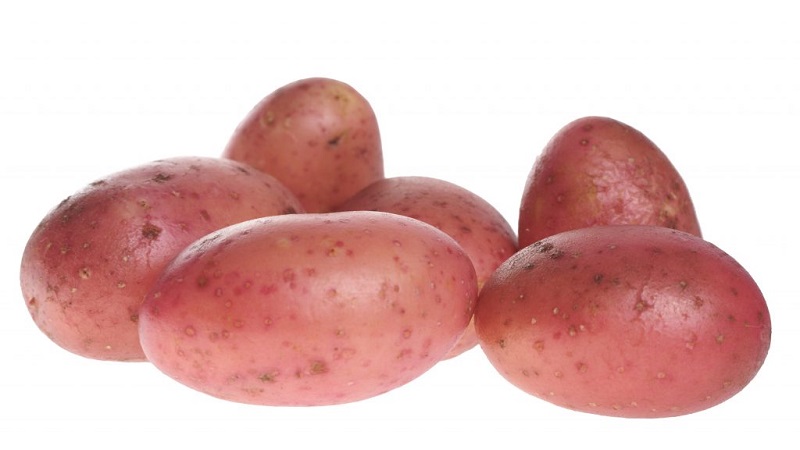
Origin and development
The Ryabinushka variety appeared and was included in the state register in 2007. It was developed by breeders of the Vsevolozhsk Potato Breeding Station (Leningrad Region). By the sum of its merits, the variety belongs to the elite and super-elite.
Over the years that have passed since its appearance, the variety has managed to spread throughout Russia and within the borders of the former USSR.
Chemical composition, trace elements and vitamins
The chemical composition of potatoes depends not only on the variety, but also on the composition of the soil, weather conditions, agricultural technology, etc.... Even the starch content of one and the same variety can vary widely - from 11 to 18%.
But, without resorting to chemical analysis, something can be determined even by the appearance of a potato:
- the red color of the peel means that the potato is rich in anthocyanins - substances from the group of bioflavonoids that strengthen the walls of blood vessels and have antioxidant properties;
- the creamy color of the pulp gives a high beta-carotene content.
In addition, Ryabinushka potatoes contain:
 water - 76.3%;
water - 76.3%;- dry matter - 23.7%;
- starch - 17.5%;
- sugar - 1%;
- fiber - 1%;
- protein - 2%;
- ash - 1%;
- organic acids - 0.7%.
Culinary the use of the Ryabinushka variety is universal.
Ripening period
Ripening period of Ryabinushka to technical ripeness - 80-90 days... You can dig it in for eating 10-15 days earlier.
Yield
Ryabinushka's yield indicators are at the level of the best elite varieties: at a seeding rate of 27-29 kg, it can give up to 400 kg per one hundred square meters or up to 40 tons per hectare! At the same time, the marketability of a variety can reach 96% - that is, rejects, waste and substandard conditions will not exceed 4%.
Disease resistance
There are no potato varieties with universal resistance to all diseases and pests. Nevertheless, the Ryabinushka variety has good immunity against many diseases, is very resistant to potato crayfish and the pest - golden nematode.
Attention! The variety is susceptible to late blight.
The appearance and characteristics of tubers
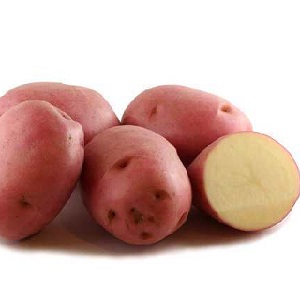 Bush of medium height, stems erect or slightly spreading... The leaves are dark green, wavy, shrinking towards the top.
Bush of medium height, stems erect or slightly spreading... The leaves are dark green, wavy, shrinking towards the top.
The flowers are violet-blue. After flowering, fruits are formed - "balabolki".
The skin of the tubers is thin, smooth, pink, sometimes (with a high content of anthocyanins) with a raspberry tint. Tubers are even, oval, smooth, eyes are small.
The average weight of a potato is 90-130 g, size is from 30 to 55 mm... The pulp is yellow, creamy, not darkening.
Which regions is best suited for
Ryabinushka is a variety with a ripening period of 80-90 days. Therefore he great for those regions of Russia that cannot boast of a long and warm summer.
This variety is recommended for cultivation in the Northern, North-Western, Central Black Earth, Volga-Vyatka regions of Russia, in the Volga region, the Far East and Western Siberia.
On the territory of the former USSR the variety is zoned in Belarus, Ukraine and Moldova.
The main advantages and disadvantages of the variety
Ryabinushka potatoes profitable it is distinguished by a harmonious combination of many advantages inherent in other varieties only individually:
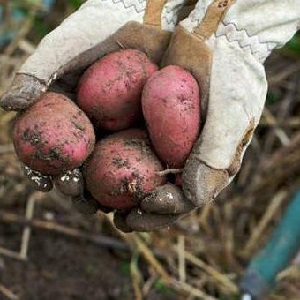 undemanding to the type of soil and growing conditions;
undemanding to the type of soil and growing conditions;- high productivity;
- evenness of tubers;
- good immunity to diseases;
- resistance to golden nematode;
- good keeping quality;
- good resistance of tubers to mechanical damage (suitability for industrial processing);
- great taste.
The disadvantages of the variety include:
- susceptibility to late blight;
- decrease in productivity in extreme conditions: during drought or heavy rains;
- the sometimes noted tendency to degeneration - which sometimes serves as an excuse for illiterate agricultural techniques.
Other varieties of potatoes:
High-yielding potato variety "White Swan"
Features of planting and growing
Agrotechnical the methods of growing the Ryabinushka variety are traditional.
Preparing for landing
About a month before planting, potatoes should be laid for germination... It is most rational to use potatoes about the size of a chicken egg, with an average number of eyes.
Reference. Planting potatoes with tubers is a vegetative, not seed, way of reproduction. Therefore, the size of the planted tuber, contrary to the opinion sometimes expressed, can in no way affect the size of the future crop or any deviations from its varietal characteristics.
Selected tubers are laid out in one layer in boxes or on a mat and left in the light at a temperature of about + 20 ° C. The first shoots should appear in about 5-7 days.
After that, the seed is harvested in a cool place (10-12 ° C) until the very planting.
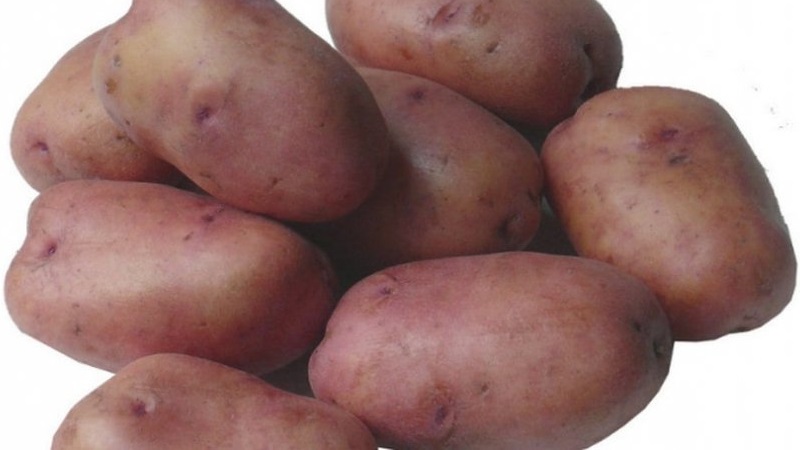
Before planting, the tubers for disinfection should be pickled in a solution of copper sulfate... Mixing methods:
- copper sulfate - 20 g, potassium permanganate - 1 g, water - 10 l;
- copper sulfate - 5 g, boric acid - 10 g, potassium permanganate - 1 g, water - 10 liters.
If tubers are cut into pieces for planting, then after each cut, the knife should be dipped in a solution of copper sulfate, and the cut should be sprinkled with wood ash.
Ground requirements
The Ryabinushka variety is not very picky about the composition of the soil, but prefers areas with fertile light soil - sandy loam.
Fertilizers, including organic ones, are applied in the fall, when plowing or digging.
Best predecessors - cereals or legumes: peas, beans, as well as perennial green manure herbs - alfalfa, lupine.
Timing, scheme and landing rules
Planting dates of the Ryabinushka variety - the same as for planting potatoes, traditionally adopted in a particular region. In central Russia, they usually fall on the May holidays, when the onset of warm weather successfully coincides with several non-working days.
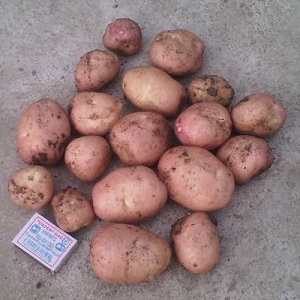 Landing scheme:
Landing scheme:
- square-nesting method with a distance between holes 25-30 cm;
- rows with a distance between bushes of 25-30 cm and a row spacing of 50-70;
- seeding rate per one hundred square meters - 27-29 kg, that is, about three buckets of seed potatoes.
A hole is dug on half a shovel bayonet (about 10 cm), a seed potato is laid, if possible, half a ladle of wood ash is poured in, sprinkled with earth and leveled.
On light to medium soils, you can do with one shovel and rake... On heavy and clayey soils, a walk-behind tractor will be a good help, and in this case it is more profitable to plant potatoes in the ridges.
Features of growing and nuances of care
Growing Ryabinushka potatoes has no specific features and is carried out according to standard rules.
Watering
In heat or prolonged drought, when there has been no rain for more than a week, Ryabinushka, like any potato variety, requires watering. It is most convenient to water the potatoes with a hose, directing the water along the aisles. When watering a small area with a watering can, the approximate norm is one bucket per sq. m. Watering is done once a week in the evening.
Loosening
Loosening of row spacings should be done once a week., the day after watering, or (unscheduled) after heavy rain.
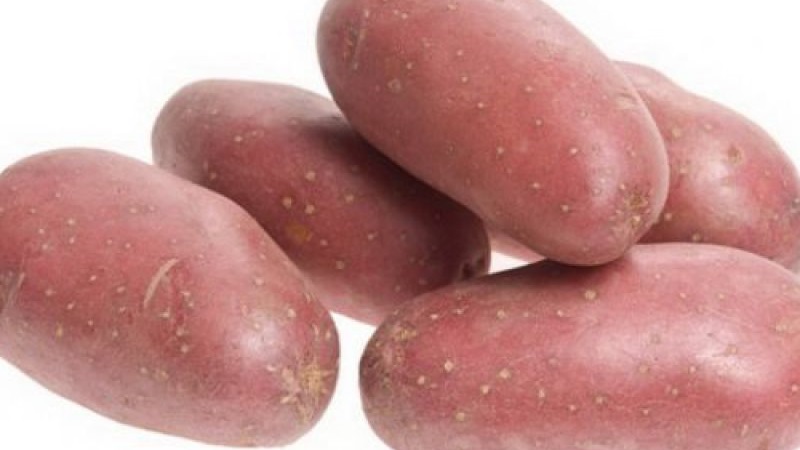
Weeding and hilling
Weeding is usually combined with loosening... In the first half of the growing season, it is carried out 1-2 times a week, in the second - once a month.
Hilling - at least twice a season: the first - at the end of May, when the sprouts reach 10-15 cm, the second - at the beginning of flowering. After heavy rains, when the earth settles around the bushes, additional hilling may be required.
Top dressing
Variety Ryabinushka accepts both mineral and organic feeding well.
First feeding: at the stage of emergence. Approximate composition:
- Urea - 1 tbsp l., water - 10 l.
- Mullein - 0.5 l, water - 10 l, hold for 3-5 days.
- Chicken droppings - 0.5 liters, water - 15 liters, stand for 3-5 days.
Consumption - 0.5 liters per bush.
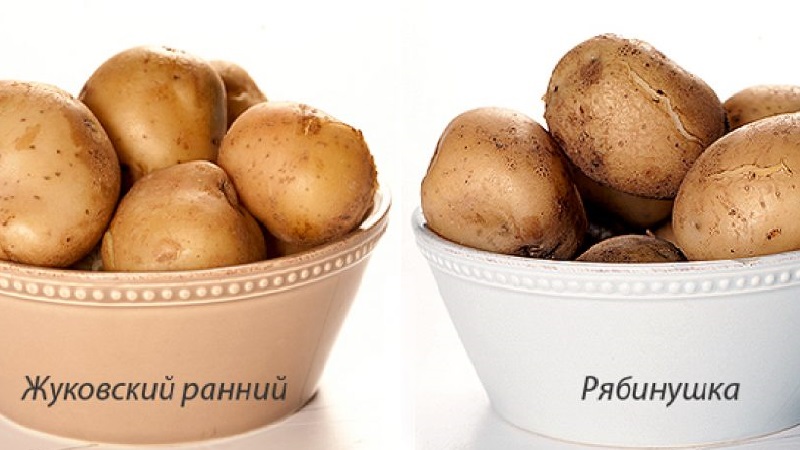
Second feeding: at the stage of bud formation. Ingredients: potassium sulfate - 1 tbsp. l., wood ash - 1 tbsp., water - 10 l. Consumption - 0.5 liters per bush. Such feeding accelerates the onset of flowering.
Third feeding (during flowering): superphosphate - 2 tbsp. l., mullein - 1 tbsp., water - 10 l. Consumption - 0.5 liters per bush.
Attention! Concentrated fresh droppings can burn potatoes. It must be diluted with water and kept for several days.
Disease and pest control
The main attack for potatoes is the Colorado potato beetle... In a small area, it can be harvested by hand or, in case of severe infestation, chemical insecticides "Decis", "Actellik", "Karbofos", etc. can be applied.
When potatoes are affected by fungal diseases - scab, late blight, alternaria, etc. - after an accurate diagnosis of the disease, use the fungicides "Quadris", "Uniform", "Shirlan" or similar.
Important! Any chemical preparations are applied strictly according to the instructions attached to the preparation, in compliance with all necessary safety measures. Harvesting in this case is possible no earlier than 20-30 days after processing.
Prevention:
 To prevent the appearance of the Colorado potato beetle, the treatment of tubers before planting with the means "Tirana", "Maxim" will help.
To prevent the appearance of the Colorado potato beetle, the treatment of tubers before planting with the means "Tirana", "Maxim" will help.- For the prevention of diseases, incl. late blight, tubers are treated with copper sulfate before planting.
- Only healthy tubers should be used for planting.
- In the aisles to scare away pests, it is worth planting pungent-smelling plants, aromatic herbs, and calendula.
- A universal preventive measure is strict adherence to crop rotation.
Harvesting and storage
Growing a good harvest is half the battle. It is also important to remove and preserve it correctly.
How and when to collect
The usual time for harvesting potatoes in the middle lane is the first half of September... Other rules include:
- Harvested in dry and sunny weather.
- The dug tubers are scattered for 2-3 hours in one layer in the sun to dry.
- Then the tubers are harvested under a canopy or in a ventilated room for 10-14 days for "quarantine".
- After that, the tubers are finally sorted out and stored in a cellar or dry storage. For better preservation, they can be powdered with dry wood ash.
- In parallel with this, you can select seed material for planting next year.
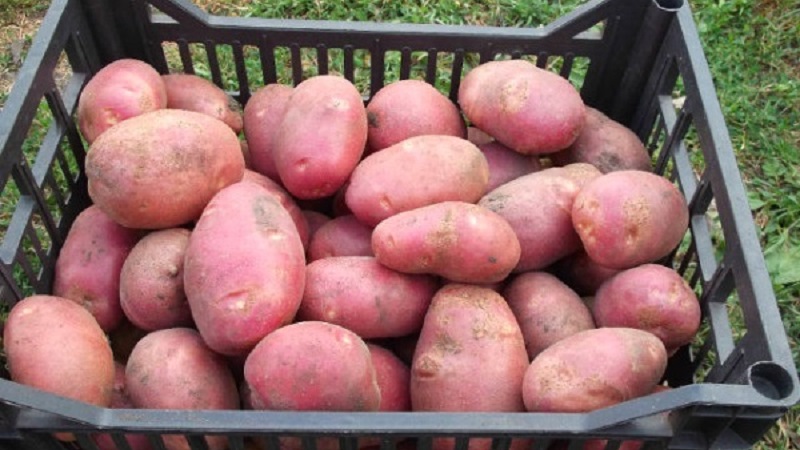
Storage features and keeping quality of the variety
The optimum storage temperature for the Ryabinushka variety is 3-4 ° С... At this temperature, keeping quality is quite satisfactory - the percentage of spoilage by spring does not exceed 10%.
Read also:
Growing difficulties
There were no particular difficulties in growing the Ryabinushka variety.... Mention should be made of the increased need of the variety for feeding, the need for watering and constant monitoring of the condition of the plants so as not to miss the invasion of pests or the development of diseases.
Tips from experienced gardeners and reviews about the Ryabinushka variety
Reviews of farmers about the Ryabinushka variety are generally positive.
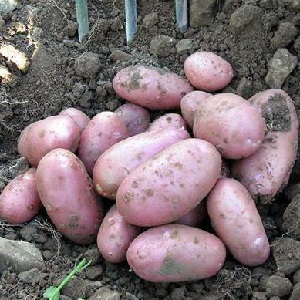 Timur, Saratov: "The variety, in my opinion, strongly depends on the year - in the heat or in the rainy season, the tubers become smaller".
Timur, Saratov: "The variety, in my opinion, strongly depends on the year - in the heat or in the rainy season, the tubers become smaller".
Alexandra, Volzhsk: “The Ryabinushka potato variety is a very rational variety. All tubers are the same size, little things are small. There are no problems with the preparation of seed material ".
Nikolay, Novgorod: “Ryabinushka perfectly accepts feeding with fresh chicken droppings. I spend it once a season, while the bushes are below 15-20 cm. It is pointless to feed overgrown plants, since this no longer affects the size of the tubers. ".
Conclusion
The Ryabinushka potato variety appeared in 2007. But it is already obvious that by the sum of its merits, it can be recommended for cultivation practically throughout the country.
Agricultural technology is standard and does not present any difficulties even for a novice farmer and gardener, and the characteristic of taste will delight you with wonderful potato dishes!